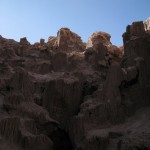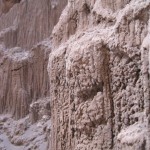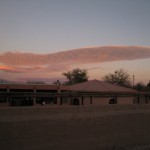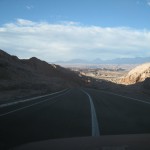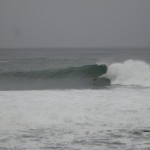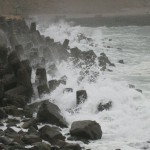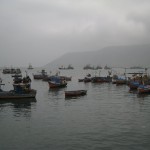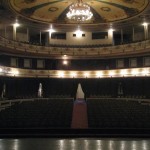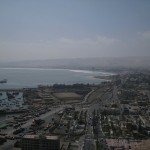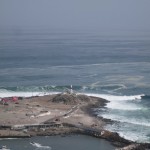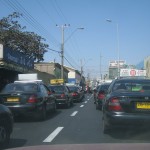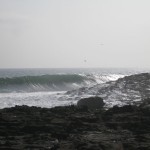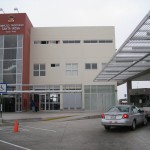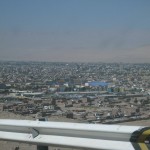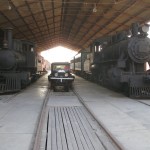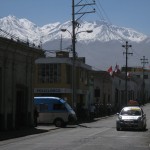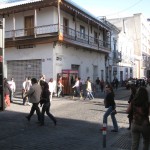this morning, i hiked around some of the nearby desert, including valle de la luna (some pics below). valle de la luna features some cool earth formations which have been surprisingly well preserved considering how fragile and unprotected they are (similar to a coral reef). it’s a little scary walking though the narrow passage and caves, knowing that most of the structure is nothing but dried mud and salt (…i wasnt sure, so i licked it).
158320
san pedro de atacama is a nice little town. it actually seems a bit like palm springs….an oasis in the middle of the desert with nice, but overpriced, food/lodging and activities. but it somehow feels more authentic (dirt road, adobe/wood exteriors and accents, etc) and more touristy (there’s not much to see in the town, so everybody goes on tours). tonight, i went on the star-gazing tour which is at the house of a french astronomer. in his backyard, he’s setup 8 nice telescopes and we saw and learned about stuff for a couple of hours. it was fun, but $30 was probably a bit overpriced (even for the us). afterwards, i grabbed a steak with a german who’s been traveling around the world for the last year.
158238
sentradiaries met motorcycle diaries today at the codelco copper mine in chuquicamata. according to lonely planet, “che guevara visited these great bleak slagheaps on his cross-continent journey, encountering a communist miner who marked a turn in his politics”. the copper mine is quite huge. the chuquicamata mine (one of three at the site), for instance is 3km x 5km and 1km deep. they process about half a megaton of material every day, with the majority being waste. because everything there is so big, it’s easy to lose perspective….until you see a big pickup truck that is dwarfed by one of the megaton trucks. they say that the trucks drive on the left side of the road (it’s easier to see the edge of the road that way)…but it seems difficult (and unlikely) for two big trucks to pass each other on such (relatively) narrow roads. another interesting fact is that they don’t work when it rains….unfortunately for the employees, the last time it rained was over 3 years ago!”
157975
today was another nice day in chile, filled with desert and ocean. it started off with a good breakfast of fresh fruit and bread at the sunny days hostel. i then drove down to the pier where they’re having a big body-boarding competition, with competitors from all over the world. as i was walking up, i saw a guy struggling with his bodyboards and equipment…so i offered to give him a hand. turns out he was a competitor in the competition. it also turns out that he’s brazilian (lives in hawaii now) and won the competition last year. he invited me up to the competitor/press booth and i got to watch part of the competition from up there. while body-boarding is cool…and i’m sure it take a lot of talent…without a deep understanding of the sport, it’s not terribly exciting to watch. i almost felt like i could do a similar job…if the huge waves didn’t break 15m from the rocks.
next, i drove over to the nearby archaeological museum of san miguel de azapa. the exhibit was relatively small, but well put together. specifically, they had some artists involved in the process, so the exhibit was interesting on a few different levels. for instance, the museum was actually built on an old olive oil farm. the building itself was built around an old olive oil press (couple hundred years old), which they kept intact and is in the center of the museum. they also have cool wrought-iron silhouettes of people/horses next to the press to show how it would have been used. it was very well done.
done with the museum, i drove back into the desert and ended up in iquique. it got a bit foggy later, so i couldn’t take good pics of the view….but it’s pretty incredible. the desert ends pretty abruptly on a few hundred meter tall cliff….with iquique and the ocean below. iquique itself is nice and features some georgian architecture in the town center. on track with what other people have told me about chile, iquique could be a nice place to live (safe, nice, etc.) but not a huge tourist destination (unless you’re very passionate about chilean-style georgian theaters, bodyboarding, or paragliding).
so far, i still really like chile. the best thing is that it’s ‘modern’, clean, safe and people are friendly/competent.
157747
so today was one of those days when everything just seemed nice, good and clean (except for a small pile of shit on the walk up to the mountain overlooking the town of arica).
arica, chile is a small beach city, which is a pleasant change to peru. things are still relatively cheap, but everything (and everyone) just seems more modern and easier to deal with. i had lunch at a small sandwhich place (still not as good as chacarero’s in boston, but close), then hiked up a large mound (150m tall) next to the center of the city. on top of the hill is a military museum which seems to be in the old army fort (arica was a fighting ground between peru/chile). it was also really nice being by the ocean. i’ve never really missed or cared for the smell of the ocean…but this afternoon i loved the smell of it…except for the periodic whiffs of urine (yes, they pee on the street here too).
i’m now at sunny days hostel. it’s nothing fancy (it’s knda homey)….but they’re definitely making a concerted effort…and it’s probably the most thought-out hostel i’ve been at yet. why? well….they have parking, reasonable-speed wifi (which covers the entire place), two computers, dorms and private rooms, dorms with lockers, laundry, kitchen and hang-out areas. after signing in, the owner also gave me a map and list of things to do, plus a small snack of juice/cake….how awesome is that?
but here’s the really surprising thing. if you were to spend a couple hours coming up with a complete list of things a hostel should have…it’d be hard to find one in latin america. it seems that almost all hostels are owned by a person or couple who decide that a hostel is easy and convert a home into one. but most miss some critical elements…..like lockers (for locking your bags up while you’re away), wifi everywhere, cleanliness, etc. sunny days may be the closest i’ve encountered so far. i think hostals here are much more in their infancy than they are in europe.
157721
the border between peru and chile at tacna is really nice. the peruvian building was finished in 2007…and everything was clean, simple and modern (it took under 20min). on the chilean side (which took about 30min), they scanned both my bags AND my car. to scan the car, they had this large truck, with an arm sticking out of it…and then they just drove the arm over the car. nonetheless, they didn’t catch my secret side-wall compartments filled with books, granola bars and water.
157698
today. i drove to the border town of tacna. tacna is another typical peruvian town, with typical peruvian people….i’m ready for some change. they do have a cool train museum, though….it’s more like an old train station (with tons of repair equipment) that’s been abandoned for over half a century. you can just walk around and climb/touch everything. tacna is also overrun with pigeons.
the drive today took me through quite a bit of desert — it’s impressive how much desert there is in the americas. tacna is right in the midde of it….pretty impressive to see such a large city (couple hundred thousand) in the middle of nothing. i also followed a van for a bit which said ”panamerica-movie.com’, i think (i still need to check it out).
peruvians don’t seem to have respect for road rules. why do i say that? well, it seems like half of the road signs on the highway are non-informative. for instance, they’ll say ‘respect the signs’, ‘don’t break the signs’, ‘trust the signs’, ‘don’t pass if you’re in doubt’, or ‘don’t speed, think of your family’. then, there’s traffic cops….who people also don’t respect. it’s not that they don’t like them (that’s more or less universal, afterall), but that sometimes cars will just ignore them….like the taxi in huaraz which just drove by one flagging him down. or when the cops pull me over, they’ll look everything over, make me wait a few minutes, then ask me for a ‘coke’ or a ‘lunch’ (aka cash). in other countries, they’ll make up some infraction and threaten you for a bribe. here, they just implore you for a handout…..like those litte kids on the cordillera blanca who would always say ‘regala me!’….and you’d appease them with a piece of hard candy.
157456
note: time of gps is wrong
well, the food poisoning finally hit me. last nigt i got up at least a dozen times, and this morning’s guided tour of a museum was hell (every few minutes i’d get cramps….i don’t think i could handle giving birth). but, now everything’s ok again…i think…which is good since i have a 6hr drive to tacna tomorrow.
like antigua (guatemala), arequipa has some towering mountains surrounding the city — they’re an awesome surprise and add a whole other dimension to the city. recently, the glaciers on the mountain tops have been melting (not necessarily because of global warming), which may sound like a bad thing…but on the plus side they’ve exposed several inkan burials. one frozen burial of a 12 year old girl, ‘juanita’, was preserved very well (skin and internal organs still intact) and can be seen at a museum here. scientists have even determined how the girl died (blow to the head), when she last ate (8hrs before death) and what her last meal was (vegetarian).
157455
today’s drive from puno to arequipa started off a bit rough…with me having to crank the engine for about a minute before it started. arequipa’s a little lower and a little warmer, so hopefully it will get easier. however, the mountain pass between the two cities reached an elevation of almost 3 miles, it’s incredible that the car can still run smoothly at such a high altitude (fyi — mount everest is about 5 miles).
arequipa center is a nice little colonial city, with a few interesting touches. for instance, rather than beeping (for the blind), the crosswalk plays a little song when it’s ok to cross. however, the song is always the same…which is probably a good thing for the blind people, but could be annoying for nearby employees. i also saw an owner hand-washing the individual leaves of the plant outside his restaurant. later, i visited the monasterio de santa catalina. lonely planet states it’s a ‘paradise for photographers’, so rather than post my shitty pictures, you’ll be better off searching the web (…i also forgot my camera in the car). the monastery is still functioning and is very big (it has little streets) and serene inside…it’s like another world.
ON GPS
when people here learn about my trip, they’ll typically be surprised by two things: one, that i’m driving alone; and two, that i don’t have a gps (which is often called ‘gps’, even in spanish…rather than ‘spg’ like the acronym should be). my answer to the first is that i’ve met friends along the way, either who live in latin america or who flew down for a leg…but that while most people are excited by the trip, they can’t commit because of real or imaginary obligations (real: family or mortgage, fake: scared to leave their job). the navigation question, however, is more interesting.
it was my original intention to buy good maps every time i entered a country. i assumed that i could get a good aaa-equivalent map at the gas stations, etc. probably not surprising to you, getting good maps is much harder than in the us. luckily, since i don’t have a real destination…having a map is not as important (…i mostly head south). lonely planet usually provides a good enough map that will get me around, although i’m sure i’m missing good places (for instance, my lonely planet isn’t big on camping…so i’ve mostly stayed in hostels and hotels). in addition, i borrowed santi’s gps unit in san jose, costa rica & i bought some detailed maps in panama city. having the gps made it much easier to navigate the busy city, as i was able to visit multiple shipping agents in just a few hours.
even the best maps of latin america, though, are just guides. in the united states, the streets and buildings are almost always clearly marked. with a map and some patience, you can usually get anywhere you need to. many latin american cities (and all towns) lack street signs and numbers. in panama city, for instance, street names on the map were different than those on the streets…and locals often times knew neither. in san jose (costa rica), houses don’t even have addresses (well, not in the traditional sense…instead they’ll write down that they live ’50m north of the coca-cola distribution plant’).
so how can you get around a place without a codified grid? sometimes i’ll follow cars….hoping they’ll lead me to the tourist destination (sometimes this backfires and i end up in a tiny suburb/village). highways will sometimes have mileage markers….with the zero typically being at a big city (although sometimes the distances will go up, then back down again). other times (esp in central america), you can spot the center of town by the big cathedral (thank god for the catholic missionaries!). but usually, i’ll ask people (in fact, i typically will ask a few people and follow the most common response). it’s also incredibly important to understand your audience….a taxi driver will usually know the area better than a supermarket clerk (who today gave me the exact opposite, and wrong, response as the cab drive outside).
but, back to gps, it seems like it can have a huge impact in 2nd and 3rd world nations. well, probably not with the current user-interface…and maybe even with different technologies (bottom-up vs. top-down). but, some sort of virtual navigation system has the ability to leap-frog the burdensome signage system present in the us…in much the same way that cell phones have leap-frogged landlines. one of the most important elements, though, is access — both access to update the information and access to the information itself. whereas signs can be costly to install/maintain….their access is free and ubiquitous. virtual navigation systems will likely need a similarly low-cost, universal approach.
but for now, i’ll just keep taking the ‘scenic route’….on purpose, i swear.
157253
this morning i drove to puno, the small port town on lake titicaca. i quickly hopped on a boat which took me to visit a few of their floating islands (built by the uros tribe). the islands are actually very neat: comfortable, pretty, simple and a cool engineering feat. what’s really impressive is how sturdy they feel…i was expecting them to rock around like a dock, but they’re actually very stable; and comfortable too….one kid was doing flips and landing on the soft reed floor.
the islands are probably about 30m x 30m (or less) and made from a stack of 2-3 meters of reeds (plus dirt); they are then tied down to the lake bottom so they don’t float away and accidentally start a war with bolivia. some islands have holes in the middle to farm fish, while others have hostels and schools. the majority of the construction is from reeds, although wood and metal are finding there ways onto the islands (along with a couch in the hostel). one interesting thing about the reed roofs, is that they apparently swell up when it rains…thus creating a water-tight seal (or so they claim). reeds are also grown on the islands (the island is living), so that it is more or less self-sustaining (every year they place down a new layer of reeds). they also make boats from the reeds….one boat takes a couple weeks to make and lasts from 1.5 – 3 years (depending on if a plastic tarp is used in the construction of the reed floats). i was also surprised that there weren’t many bugs on the islands; after all, they seem like a pretty good place for decaying vegetable matter and insects (reeds + water + sunlight).
overall, the idea is really elegant and seems environmentally sustainable — probably one of the most exciting systems i’ve seen yet (even more elegant than the panama canal).
but now for some downers. first, although people ‘live’ on the islands, they survive entirely off of tourism. the islands themselves are built and maintained for tourists (some of the islands were built as recently as 2000). also, on my boat, i think there were some uros pretending to be tourists…and buying little trinkets at all the islands, then showing them off in hopes that we would buy stuff too. also, as patrik warned me, the boat tour lasts a bit too long….they kinda trap you on the islands so you’ll buy stuff. finally, i don’t like to publish criticisms….but contrary to what everybody’s said about peru, i’m ready to leave (…well at least the highlands region).
as a side note, this evening my car is residing in the high school stadium parking lot….which also happens to be next to ‘singer’ alley (seriously, 8 identical little carts with beautiful singer sewing machines).
